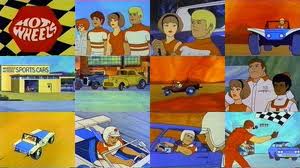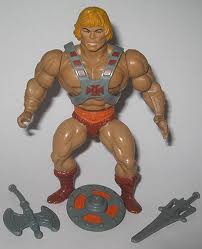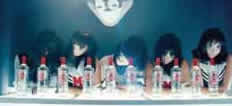Children's movies have become massive marketing enterprises giving rise to licensed toys and related products for sale, advertising through product placement and other marketing opportunities.
The release of the film Star Wars in 1977 was a  watershed giving rise to a vast range of licensed toys with multiple marketing strategies in terms of form, price, packaging, collectability and characterisation. Sales by manufacturer Kenner of toys associated with the film reached $US100 million in the first year of Star Wars toys production.
watershed giving rise to a vast range of licensed toys with multiple marketing strategies in terms of form, price, packaging, collectability and characterisation. Sales by manufacturer Kenner of toys associated with the film reached $US100 million in the first year of Star Wars toys production.
The ongoing release of films in the Star Wars series stimulated frenzied collections and fandom, first among children and later among the adults they became. Star Wars action figures and accessories were far more integrated than any toy before them. A child-consumer of such merchandise at the time later reflected on the Star Wars range which consisted of
…everything from large-scale vehicles and playsets to smaller accessories, fabulous creatures and a whole host of storage cases…Kenner had allowed them [kids] to recreate virtually every scene from their favourite movie. Moreover, there was always something new for them to get for the holidays, or for birthday parties, or simply on those occasions when their mothers took them to the local department store and caved in to the constant pleading for a new mini-rig, vehicle or playset — that toy without which that next adventure could not be staged.
From the Lucasfilm/Kenner point of view there is no satisfaction to be had from play sustainability, durability and play satisfaction. In fact the more quickly that a child becomes bored and dissatisfied with a toy the better, so they will be more likely to buy the next toy. The success of a toy, and indeed a movie, is measured in terms of its profitability not the pleasure it gives a child.
 When the animated movie Land Before Time was launched in 1988 with co-ordinated in-store promotion at more than 1,400 Penney department stores and 5,800 Pizza Huts, the multi-pronged tie-in was described as “perhaps the most extensive in Hollywood history.” Penney executives claimed retail was becoming “an extended form of entertainment” with children expecting “to be able to extend the fantasy of a film and take the characters home with them, either in the form of a book, a tee-shirt or whatever.” The industry term for this was “entertainment alliances”.
When the animated movie Land Before Time was launched in 1988 with co-ordinated in-store promotion at more than 1,400 Penney department stores and 5,800 Pizza Huts, the multi-pronged tie-in was described as “perhaps the most extensive in Hollywood history.” Penney executives claimed retail was becoming “an extended form of entertainment” with children expecting “to be able to extend the fantasy of a film and take the characters home with them, either in the form of a book, a tee-shirt or whatever.” The industry term for this was “entertainment alliances”.
Often the licensed products and sales of toys make more money for a movie producer than the movie itself. For example the movie Aladdin cost $US20 million to make but $US25 million was spent promoting it to ensure the predicted sales of licensed products worth some $US250 million, videos worth $US200 million and video games worth another $US200 million. The first two Star Wars movies grossed about $600 million but the merchandise that was tied into the movies was worth some $2 billion by 1985.
Movie studios naturally favour movies that are shopping mall friendly. The general manager of Columbia Pictures Merchandising stated that “There is no question people look at scripts for their licensing potential” and do market studies of this potential. The tendency towards sequels in movies is partly driven by the need to keep the characters emblazoned on the products current and fashionable.
 In 1969 Mattel sponsored a television cartoon series called Hot Wheels, based on its toy cars of the same name, but following complaints to the Federal Communications Commission (FCC) about the nature of the show, the cartoon series was discontinued. However, by 1983 there was a completely different regulatory climate in the USA and the FCC let it be known that it would no longer look disfavourably upon what were essentially “program-length commercials” or PLCs.
In 1969 Mattel sponsored a television cartoon series called Hot Wheels, based on its toy cars of the same name, but following complaints to the Federal Communications Commission (FCC) about the nature of the show, the cartoon series was discontinued. However, by 1983 there was a completely different regulatory climate in the USA and the FCC let it be known that it would no longer look disfavourably upon what were essentially “program-length commercials” or PLCs.
This prompted Mattel to produce a television programme for the US market based on its toy line He-Man and Masters of the Universe. In 1984 there was  $US500 million worth of He-Man gear sold. He-Man marked a watershed and there was soon a frenzied fray of toy companies seeking to take advantage of the relaxed regulatory climate. By 1984 there were eight Saturday morning network programmes in the US based on toys and other merchandise, including Strawberry Shortcake and Care Bears.
$US500 million worth of He-Man gear sold. He-Man marked a watershed and there was soon a frenzied fray of toy companies seeking to take advantage of the relaxed regulatory climate. By 1984 there were eight Saturday morning network programmes in the US based on toys and other merchandise, including Strawberry Shortcake and Care Bears.
Toy manufacturers sought to promote their toys by having them at the core of children’s television programmes. This not only gave publicity to the toys but suggested exactly how play should be enacted around them, in much the same way as Star Wars had done. It was most profitable for television shows to feature several characters needing various accessories so as to maximise the product lines that can be sold. The well thought out marketing driven programme involves a team of toy heroes, their enemies, the costumes, weapons, vehicles and other accessories.
Toy manufacturers have become key players in the development and promotion of children’s television programmes. They often subsidise the production of programmes that will promote their products, and some even go so far as to offer the programmes to the media free in return for a share in the advertising time the programme has allocated to it. This makes is much more difficult for educational and non-commercial programmes to compete. Consequently television programming is determined by toy manufacturers interests rather than children’s interests. Programmes are developed specifically to sell toys.
 Product placement in children’s movies and television shows, where the producer is paid to insert one or more branded products into scenes, is becoming more common. Most movies now contain more than ten product placements. For example, “Pepsi has a whole department dedicated to product placement” which has paid to have its products appear in many movies including Teenage Mutant Ninja Turtles, Flashdance, Fantastic Four, Spider-man II and Back to the Future II.
Product placement in children’s movies and television shows, where the producer is paid to insert one or more branded products into scenes, is becoming more common. Most movies now contain more than ten product placements. For example, “Pepsi has a whole department dedicated to product placement” which has paid to have its products appear in many movies including Teenage Mutant Ninja Turtles, Flashdance, Fantastic Four, Spider-man II and Back to the Future II.
Almost 11 per cent of minutes on American network television included a branded reference in 2006 and there was a 13 per cent increase in product placements in prime-time network television during 2007 – almost 26,000 instances in the top ten programmes.
 Product placement helps to make a product seem familiar and gives it status when it is used by a child’s heroes. It is particularly hard for children, who use the media as a way of learning what is cool, to discern the advertisements concealed in the content of the media. Even college students, who admit they take notice of products used in movies and television, seldom realise that companies pay for their products to appear.
Product placement helps to make a product seem familiar and gives it status when it is used by a child’s heroes. It is particularly hard for children, who use the media as a way of learning what is cool, to discern the advertisements concealed in the content of the media. Even college students, who admit they take notice of products used in movies and television, seldom realise that companies pay for their products to appear.
Product placement enables advertisers to bypass the cynicism that older children may have towards standard advertisements because they are not obviously advertisements and the association between the film stars and the product is more subconscious.
At its extreme product placement becomes the total rationale for a movie or television show. In other words the movie concept begins with a product and is  designed around the product. The $50 million animated movie Foodfight!, released in 2002, was basically a movie length advertisement for multiple products aimed at children. It was set in a supermarket and portrayed “adventures of hundreds of internationally branded characters from the familiar packages of products including Mr. Clean, Twinkie the Kid, Charlie the Tuna, Mrs Butterworth…. as they battle the evil Brand X for control of the store.” Foodfight! allowed the producers to showcase products and brand characters representing “all of the biggest consumer companies in the world”. For each country the movie was released in, the products show-cased were digitally changed and customised to suit the local market.
designed around the product. The $50 million animated movie Foodfight!, released in 2002, was basically a movie length advertisement for multiple products aimed at children. It was set in a supermarket and portrayed “adventures of hundreds of internationally branded characters from the familiar packages of products including Mr. Clean, Twinkie the Kid, Charlie the Tuna, Mrs Butterworth…. as they battle the evil Brand X for control of the store.” Foodfight! allowed the producers to showcase products and brand characters representing “all of the biggest consumer companies in the world”. For each country the movie was released in, the products show-cased were digitally changed and customised to suit the local market.
Product placement is not confined to movies and television programmes. In 2005 McDonalds offered to pay rap artists who included Big Macs in their songs. The company Maven Strategies specialises in getting paid product placements into rap songs, which some major brands see as a way for to reach a younger audience and be seen as cool.
Product placement is already occurring in comic books. Similarly  children’s books can include product placements and also product integration, where the product becomes part of the story line. Books based on licensed characters from movies, television shows and consumer products are now commissioned by marketers and churned out by publishing houses. These books have no literary merit but can have the effect of diverting children from more character building reading.
children’s books can include product placements and also product integration, where the product becomes part of the story line. Books based on licensed characters from movies, television shows and consumer products are now commissioned by marketers and churned out by publishing houses. These books have no literary merit but can have the effect of diverting children from more character building reading.
Teen magazines merge editorial content with marketing and the articles promote a consumer-oriented lifestyle, with a heavy emphasis on fashion and material concerns. Magazines aimed at children also include articles, advice columns, games, cartoons and quizzes that often seek to sell products without the young reader being aware of it. This is referred to as advertainment and is used by companies such as Hershey, Colgate and Foot Locker.
A brand therefore appears as a passive but pervasive background reference, permeating the settings that connect the brand to a particular set of values or attributes, but doing so in a way that is not identifiable as conspicuous advertising. By becoming an indelible part of an experience or lifestyle, a successful youth brand is not simply attached to a subculture, but is positioned as one of its defining features.
 Product placement has been a favourite strategy of alcohol and tobacco companies which are prevented from advertising directly to children. Eight alcohol companies placed their products in some 233 motion pictures in 1997–98 and in 181 television series. A 2008 study of US movies found 83 percent showed alcohol use and about half depicted specific brands of alcohol.
Cigarette smoking in movies has been increasing in recent years with three out of four films showing onscreen smoking in 2006.
Product placement has been a favourite strategy of alcohol and tobacco companies which are prevented from advertising directly to children. Eight alcohol companies placed their products in some 233 motion pictures in 1997–98 and in 181 television series. A 2008 study of US movies found 83 percent showed alcohol use and about half depicted specific brands of alcohol.
Cigarette smoking in movies has been increasing in recent years with three out of four films showing onscreen smoking in 2006.
A 2012 study found that "the average US adolescent is
exposed to 34 references to alcohol in popular music daily", a  significant proportion of these specifying brands.
significant proportion of these specifying brands.
Studies have shown that children between 10 and 14 are almost three times more likely to begin smoking if they have been exposed to a great deal of smoking in movies, particularly if they come from a non-smoking home, presumably because smoking seems more glamorous to them. The American Academy of Pediatrics noted in 1999 that:
Increasingly, media messages and images are normalizing and glamorizing the use of tobacco, alcohol, and illicit drugs. Tobacco manufacturers spend $6 billion per year, and alcohol manufacturers $2 billion per year, to entice youngsters into ‘just saying yes.’ Popular movies are often showing the lead character or likeable characters using and enjoying tobacco and alcohol products.